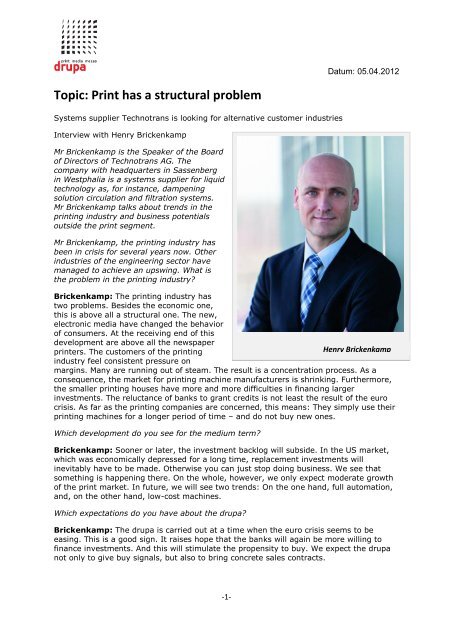Topic: Print has a structural problem - Messe Düsseldorf
Topic: Print has a structural problem - Messe Düsseldorf
Topic: Print has a structural problem - Messe Düsseldorf
You also want an ePaper? Increase the reach of your titles
YUMPU automatically turns print PDFs into web optimized ePapers that Google loves.
<strong>Topic</strong>: <strong>Print</strong> <strong>has</strong> a <strong>structural</strong> <strong>problem</strong><br />
Systems supplier Technotrans is looking for alternative customer industries<br />
Interview with Henry Brickenkamp<br />
Mr Brickenkamp is the Speaker of the Board<br />
of Directors of Technotrans AG. The<br />
company with headquarters in Sassenberg<br />
in Westphalia is a systems supplier for liquid<br />
technology as, for instance, dampening<br />
solution circulation and filtration systems.<br />
Mr Brickenkamp talks about trends in the<br />
printing industry and business potentials<br />
outside the print segment.<br />
Mr Brickenkamp, the printing industry <strong>has</strong><br />
been in crisis for several years now. Other<br />
industries of the engineering sector have<br />
managed to achieve an upswing. What is<br />
the <strong>problem</strong> in the printing industry?<br />
-1-<br />
Datum: 05.04.2012<br />
Brickenkamp: The printing industry <strong>has</strong><br />
two <strong>problem</strong>s. Besides the economic one,<br />
this is above all a <strong>structural</strong> one. The new,<br />
electronic media have changed the behavior<br />
of consumers. At the receiving end of this<br />
development are above all the newspaper<br />
printers. The customers of the printing<br />
Henry Brickenkamp<br />
industry feel consistent pressure on<br />
margins. Many are running out of steam. The result is a concentration process. As a<br />
consequence, the market for printing machine manufacturers is shrinking. Furthermore,<br />
the smaller printing houses have more and more difficulties in financing larger<br />
investments. The reluctance of banks to grant credits is not least the result of the euro<br />
crisis. As far as the printing companies are concerned, this means: They simply use their<br />
printing machines for a longer period of time – and do not buy new ones.<br />
Which development do you see for the medium term?<br />
Brickenkamp: Sooner or later, the investment backlog will subside. In the US market,<br />
which was economically depressed for a long time, replacement investments will<br />
inevitably have to be made. Otherwise you can just stop doing business. We see that<br />
something is happening there. On the whole, however, we only expect moderate growth<br />
of the print market. In future, we will see two trends: On the one hand, full automation,<br />
and, on the other hand, low-cost machines.<br />
Which expectations do you have about the drupa?<br />
Brickenkamp: The drupa is carried out at a time when the euro crisis seems to be<br />
easing. This is a good sign. It raises hope that the banks will again be more willing to<br />
finance investments. And this will stimulate the propensity to buy. We expect the drupa<br />
not only to give buy signals, but also to bring concrete sales contracts.
<strong>Topic</strong>: <strong>Print</strong> <strong>has</strong> a <strong>structural</strong> <strong>problem</strong><br />
Can packaging printing compensate for what is lost in publication printing?<br />
-2-<br />
Datum: 05.04.2012<br />
Brickenkamp: Packaging printing is a growth segment; and, in fact, specifically due to<br />
the new media. If more and more goods are ordered and bought via the Internet, more<br />
and more goods must be packed, printed and dispatched. In addition, the package is<br />
gaining in importance as a distinguishing characteristic of products. It is difficult to say to<br />
which extent this growth segment can make good for declines in other areas.<br />
Are you also doing business with digital printing?<br />
Brickenkamp: We are on the road with many manufacturers. Not at the lower end of<br />
our product range. For Technotrans, it is getting interesting as soon as digital printing<br />
machines are capable of moving into the performance range of offset printing. This is the<br />
segment where we see positive growth tendencies.<br />
In 2011,Technotrans had to cope with high value adjustments due to bad debt losses<br />
caused by the insolvency of Manroland. Now, Manroland is back in the market with two<br />
separate companies. Will Technotrans do business with them again?<br />
Brickenkamp: We have held preliminary talks with both companies which emerged from<br />
the insolvency. These talks were quite promising. I expect the webfed and the sheetfed<br />
company to remain an important customer of Technotrans.<br />
Technotrans wishes to decrease its dependence on the printing industry and increase the<br />
portion of sales made outside this industry to 30 per cent in the course of the next three<br />
years. How will you do that?<br />
Brickenkamp: With the acquisition of Termotek AG last year, we entered the laser<br />
cooling segment and thus opened the door to an interesting growth market. Most<br />
recently we made a cooperation agreement with KLH-Kältetechnik. As a result, we are<br />
now also present in industrial cooling and plant engineering. Furthermore, we have our<br />
eye on other industries as well, for example, machine tool building. Technotrans<br />
manufactures temperature control systems, with temperature being controlled above all<br />
by means of fluids. There are a lot of industrial sections where they can be used. In the<br />
medium term, we wish to make about 50 per cent of our sales with new customers in<br />
new industrial sectors.<br />
Other suppliers of the printing industry are looking for new industrial sectors as well in<br />
order to reduce their dependence on this weakened industry. Do you run across your<br />
existing competitors in the new business areas, too?<br />
Brickenkamp: No. We have an outstanding market position in specific areas and with<br />
specific products. This is where we are global market leaders, for instance, in<br />
temperature control systems for dampening solutions. Other companies focus on other<br />
processes. We don`t get in each other`s way, and this won`t be the case in other<br />
industries and markets either.
<strong>Topic</strong>: <strong>Print</strong> <strong>has</strong> a <strong>structural</strong> <strong>problem</strong><br />
Key questions<br />
Why is there a future for printing?<br />
-3-<br />
Datum: 05.04.2012<br />
Brickenkamp: For three reasons. In spite of the electronic media, paper will continue to<br />
be the major carrier for media because of its higher qualitative value. Secondly, the new<br />
media also generate classic print business. I just mention the catchword “cross media”.<br />
And thirdly, packaging printing will continue to rise and push the printing industry.<br />
The drupa turned 60 last year. Will there still be a drupa in 60 years from now on?<br />
Brickenkamp: I don’t think so, at least not in its present form. The large trade shows<br />
will get smaller and, above all, shorter. This also applies to the so-called flagship fairs. In<br />
addition, I see a tendency towards, for instance, in-house exhibitions in order to care<br />
about customers very individually. On the other hand, flagship fairs are always important<br />
market places where people meet and communicate. Business is always generated by<br />
people; there is nothing that’s more efficient. Nevertheless you`ve got to ask yourself<br />
whether 14 days is not too long for a drupa already now, above all since the original<br />
main reason for these two weeks, i.e., the installation of very large webfed printing<br />
machines which simply wouldn`t be worth the trouble for just a few days, is to a large<br />
extent no longer valid now.<br />
Which further development was the most important one since the invention of letterpress<br />
printing?<br />
Brickenkamp: I wouldn`t say that there is just one special further development which<br />
stands out in particular. On the contrary: From my point of view, it`s a continuing<br />
process that pushes printing technology. The catchwords in this respect are automation<br />
and print finishing. They have always been drivers of innovation.<br />
The drupa trade fair takes place in <strong>Düsseldorf</strong> from 3 to 16 May 2012. A trade show<br />
organized every four years, it is by far the largest event of the printing industry worldwide.<br />
This is where trends are set for the years to come.<br />
The German printing machinery industry is the global market leader and will continue to<br />
maintain this status in future as well. Every month in the run-up to the drupa, the VDMA<br />
will offer an interview with one exhibitor of the industry in the form of a press release.
















